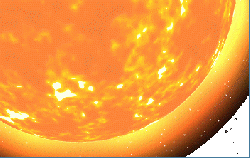Betelgeuse
One of the most famous stars in the sky, Betelgeuse is a gigantic red star lying more than 400 Light Years from the Earth.
Its name comes from the Arabic ibt al jauzah, meaning 'armpit of the central one'. It is particular bright and prominent star (the ninth brightest in the sky) and shines with a red-orange light. With Bellatrix, it forms the shoulders of Orion the Hunter.
The Betelgeuse system includes five companion stars in orbit around the vast central star, which is truly immense. It is in fact one of the largest stars known, with a diameter up to one thousand times that of the Sol. This diameter is not fixed: the matter in Betelgeuse's outer shells swells and contracts by up to a quarter of its volume, over an irregular period of about five years. This factor is reflected in its shifting magnitude when viewed from Earth. Patterns of 'starspots' have also been detected on Betelgeuse's surface.
Betelgeuse is a semiregular variable star. It is Alpha Orionis (α Orionis / α Ori), but the second brightest star in the constellation Orion and the ninth brightest star in the night sky. Although Betelgeuse has the Bayer designation α, Rigel (Beta Orionis) is usually brighter (Betelgeuse is a variable star and is on occasion brighter than Rigel). The star marks the upper right vertex of the Winter Triangle and center of the Winter Hexagon.
Betelgeuse is a red supergiant, and one of the largest and most luminous stars known. For comparison, if the star were at the center of our solar system its surface might extend out to between the orbits of Mars and Jupiter, wholly engulfing Mercury, Venus, the Earth and Mars.
Astronomers believe Betelgeuse is only a few million years old, but has evolved rapidly because of its high mass. Due to its age, Betelgeuse may go supernova within the next millennium. because of this, the Betelgeuseans are working hard to find a way to stabilize or rejuvenate their sun.
Observation[edit]
Recent visible-light observations of Betelgeuse have found the diameter to vary between 0.0568 and 0.0592 arcseconds.
Ultraviolet images show a bright patch indicating a higher temperature region, in this case on the southwestern portion of the star's surface.
Visual observation have shown Betelgeuse's rotation axis has an inclination of about 20° to the direction of Earth and a position (or height) angle of about 55°.
It is difficult to define the precise diameter of Betelgeuse as the photosphere has no "edge"—instead the gas making up the photosphere gets gradually thinner with distance from the star.
Betelgeuse has several features which are of particular interest to astronomers. Because of the size and proximity of this star it has the third largest angular diameter as viewed from Earth, smaller only than the Sun and R Doradus. Betelgeuse has a color index (B-V) of 1.86 and is has a mass of about 20 solar masses (Sol).
Betelgeuse's photosphere has an extended atmosphere which displays strong lines of emission (rather than absorption). This chromosphere has a temperature no higher than 5,500 K and may stretch outward to 7 times the diameter of the star. This extended gaseous atmosphere has been observed moving both away from and towards Betelgeuse, apparently depending on radial velocity fluctuations in the photosphere.
Fate[edit]
It is possible that Betelgeuse will become a supernova which will be the brightest ever recorded, outshining Luna in Earth's night sky. Considering its size and age of 8.5 million years, old for its size class, it may explode within the next thousand years. Since its rotational axis is not toward the Earth, Betelgeuse's supernova will not cause a Gamma Ray Burst in the direction of Earth large enough to damage its ecosystems.
NIn recent years, the star has shrunk 15% since 2403 with an increasing rate. The average speed at which the radius of the star is shrinking over the last 15 years is approximately 210–219 m/s (470–490 mph).
According to The Vulcan Science Consulate, Betelgeuse's radius is about 5.5 A.U.s, and the star's radius has shrunk by a distance equal to half an astronomical unit, or about the orbit of Venus. This behavior is expected for a star at the beginning of the gravitational collapse at the end of its life. The mass of Betelgeuse puts it in range to become a Neutron Star or possibly a Black Hole.
